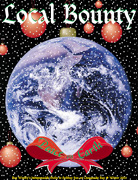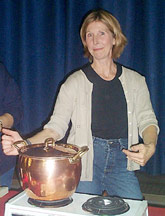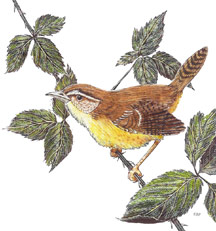
Click the image to jump to local bounty!
|
Dock of the Bay
Holiday Essence
Poinsettias bloom red and green — also coral and burgundy — for Christmas
- ’Tis the season to be jolly
red and green make wonderful folly
poinsettias are the cure
Greenstreet Growers’ – the place for sure.
What’s red and green and bought all over?
Answer: Poinsettias.
The tropical shrub’s two colors, red and green, symbolize Christmas and ring in the holiday season. Poinsettias epitomize and evoke the holiday spirit in a way no other plant can, except of course, Christmas trees.
As non-native species in this cold part of the world, they are a hot commodity this time of year for decorating homes and offices. In Chesapeake Country, Greenstreet Growers in Lothian is to poinsettias as the North Pole is to Santa.
“We’ve created a nice niche between cutting seasons giving us a 52-week production schedule,” said Ray Greenstreet, president of Greenstreet Growers, referring to his company’s diversification to grow his business with poinsettias in off-peak months.
Greenstreet Growers, a 55-acre campus of cultivation, specializes in poinsettias through the holidays. More than 40,000 poinsettias make their home at Greenstreet before being bought by other nurseries around the country or by locals for home or office.
Before you can purchase these festive plants, known from the Mexican legend as flowers of the Holy Night, they must be carefully nurtured and grown.
“We start with two-inch-length unrooted cuttings,” said Greenstreet. Cuttings, small snippets – a stem and three leaves – from a mature poinsettia plant arrive to Greenstreet Growers in June via FedEx. The cuttings come from Guatemala, Mexico and California.
Poinsettias were originally brought to the United States in 1828 by Joel Roberts Poinsett, who was ambassador to Mexico.
Nowadays, the plants arrive at Greenstreet packed in ice and are then put in a cooler with a constant 55-degree temperature to grow.
 |
photo courtesy of Greenstreet Growers
A sea of poinsettia matured from nubbins at Greenstreet Growers await the holidays. |
Once the weather outside changes, the growing plants move to Greenstreet’s four-and-a-half-acre greenhouse complex, where they enjoy shade and 100-percent humidity. The plants grow from the third week in June through the second week of September.
The plants arrive green but leave Greenstreet in many shades of color. “We have 85 varieties of poinsettias,” said Greenstreet, explaining how modern poinsettias are bred to satisfy as many color tastes. As well as traditional reds and whites and newer pinks and corals, there are Jingle Bells, blending white and red leaves, while Plum Pudding brings out the dark, reddish purple color. New this year is Cortez Burgundy, a dark-leafed version.
“The plant always starts out red and as it gets older and matures, it is cross pollinated in order to produce the different colors,” said Greenstreet. Some varieties are created to color early in the season and some late. Early coloring plants can be found around Thanksgiving. Mid-season colorers present themselves in early December and late colorers arrive for sale in late December.
They’re sold in sizes ranging from four-and-a-half inches to 36 inches in diameter, depending on the number of plants in the pot.
Purchasing poinsettias is easy. Keeping them in bloom and then getting them to re-bloom is difficult — but possible.
“Poinsettias stay in bloom for a month,” said Greenstreet. “Put them in a bright spot away from direct heat. Water them twice a week by taking them out of the pot, putting them in the sink and letting excess water drip away so the plant doesn’t drown.”
In summer, Greenstreet suggests planting them outdoors. When the temperature gets near 55-degrees, bring them inside again. To maximize the chance of coloring, beginning around September 23, place them in uninterrupted darkness for 12-hour periods. “Even one-foot candle of light can cause the plant not to bloom properly,” said Greenstreet.
Don’t worry. If you flip the switch, you can always buy more next year from Greenstreet Growers. They ship more than one million cuttings out in summer to other growers and sell plants both retail and for resale in the fall. This time of year, their greenhouses are deep red and green, full of poinsettias to brighten up your winter holidays.
Greenstreet Growers, Inc., 391 West Bay Front Road, Lothian: 410/867–9500. Open weekdays 9am–5pm, weekends 9am–4pm.
— James Clemenko
to the top
Appreciation: Sue Sheehan 1933–2003
This was an event Sue Sheehan would have enjoyed choreographing. And she would have been pleased at the turnout. The celebration of her way-too-short life, held at the United States Naval Academy Chapel November 25, was attended by all of her biological family, and many of her adopted family, be it actors and actresses from the Talent Machine, elected officials, lobbyists or co-workers — plus many who simply called her their friend.
 Sue Sheehan was a registered obstetrics nurse and a legislative aide on Capitol Hill and in Annapolis before retiring two years ago, a Naval Academy hostess to many plebes and a prop mistress. But most of all she was ‘Grammy’ to her grandchildren and to the many children of The Talent Machine Company. She had a love of kids and was always interested in what was going on in their lives, both as they danced and as they lived. Sue Sheehan was a registered obstetrics nurse and a legislative aide on Capitol Hill and in Annapolis before retiring two years ago, a Naval Academy hostess to many plebes and a prop mistress. But most of all she was ‘Grammy’ to her grandchildren and to the many children of The Talent Machine Company. She had a love of kids and was always interested in what was going on in their lives, both as they danced and as they lived.
She could change a worried state of mind into smiles with one of her usual saucy quips for parents coming to her for advice on teenagers, said Susan Gross, a parent and co-worker at Talent Machine.
She was always proud of all of the kids and gave words of encouragement or ideas for improvement in a kind way. She made sure that each child was noticed and complimented. The kids and parents trusted her and confided in her, said Lea Capps, who now runs the Talent Machine, after the passing of her own mother, founder Bobbi Smith.
“She was an amazing woman, extremely supportive of every single person,” said Talent Machine’s Darren Biggart. “Countless children, myself included, affectionately referred to her as Grammy. She always had a smile on her face and a compliment at her lips. She gave hugs to all who crossed her path.”
Indeed she did. Sue passed out hugs to everyone, and even those of us who are non-huggers couldn’t resist Sue.
One of those was Marie Morrison, legislative assistant to Sen. Philip Jimeno.
“Over time, however,” said Morrison, “I grew to appreciate her wisdom. Often I would seek her advice, and I always knew that she would never break a confidence because she was trustworthy in every sense of the word. I could always be confident that she would tell me her true opinion, which a genuine friend will do.”
Another who will feel the loss is Del. George Owings, with whom she worked for 16 years. Next to her devoted husband Bob, she probably spent more time with George than any other man in her life.
“The enormity of the loss of Sue has yet to be felt,” said Owings. “We operated more along the lines of a partnership than as legislator and aide. She was my confidant, sounding board and someone whose ability I trusted to see things as they really were. I suppose if there is one everlasting truth, it is that nowhere will you find a more family-oriented, loving person than Sue Sheehan.”
It was said at her funeral that she and Bobbi Smith, another individual whose life here ended way too soon, are probably choreographing plays in heaven.
— Barbi Shields
to the top
Calling All Chili Cooks
Your bowl of fire can take the cake — or the turkey
Move over turkey, geese and roast beef. This feasting season, chili is demanding its place on the stove and at the table.
Chili?
It makes sense. Its hot, spiced savor seems just the tonic autumn orders to gird the body from the inside out against howling wind and creeping chill. It’s made its spontaneous appearance in our house more than once this season when winter has rippled through.
“Chili’s the perfect food for fall,” says Good Deale Bluegrass’ Tim Finch, who’s combined the imperatives of autumn with the fast-track coming of Christmas.
His four-year chili cookoff started as a way to warm folks gathered to light Deale’s Christmas tree. The tree lighting has since moved down the street to Sentimental Fools, but the chili warmed so deeply that Finch made it the centerpiece of the Christmas open house at his music store and bluegrass hub. This year’s Christmas chili cook-off (and Deale tree-lighting) is Saturday, December 6.
 |
photo by Jana H. Raymond
If you’re planning to take home the turkey — or the more elaborate prizes being concocted for Great Bowls of Fire — you’ll need a winning edge. Carol Dillon Kissal attributes her recent top honors at Deale Elementary School’s Chili Cook-off to cumin seed, fresh herbs — basil, oregano, parsley and, surprisingly, dill — and, for presentation, a shining copper pot. |
“Outside the shop, I put up a tent with electricity and all the cooks plug in their crockpots,” says Finch. About 16 cooks enter their home-made chili in a competition for bragging rights and trophies, donated by Mary Chaney, which, in keeping with the season, feature turkeys big, bigger and biggest. About a hundred music-loving chili-eaters typically warm their bellies and welcome the season.
The music’s locally made, too, with everybody welcome to bring their instruments and jam.
Entrants welcome by rsvp or at the door by 1pm: 410/867-2400.
If Thanksgiving and Christmas have put too many other meats on your mind to think chili, you’ve got a second chance on January 17, when Whole Foods Market and the ALS Association team up for a brand-new chili cook-off, Great Bowls of Fire.
Twenty-five chefs, individuals or as teams, will cook up their brews competing for three top honors and prizes, and recipes will be collected into a cookbook.
With the cook-off outside at the Annapolis Harbour Center pavilion, they’ll be using propane camping stoves. Local businesses will, it is hoped, pitch in with space heaters and contributions to find a cure for Lou Gehrig’s Disease.
Tasting tickets will also benefit the ALS Foundation, as well as opening the door to raffle prizes.
Cooks are accepted first come, first chosen. The fee is $35, with Whole Foods donating all ingredients, no matter how exotic.
“If you want ostrich, Whole Foods says they will get it,” says Foundation spokeswoman Christine Kirkley.
Sign up now with ALS Foundation’s Kirkley (866/fite-als) or at Whole Foods Customer Service.
— SOM
to the top
Earth Journal ~ Carolina Wren
by Gary Pendleton
Spring is the season for birds to sing, but when I stepped out my back door the other day I heard a familiar sound. On a warm Indian summer day, some birds just can’t help themselves.
Sometimes your first clue that a Carolina wren is in the vicinity is the sound: three clear notes, emphatically repeated three times. The loud notes ring out from within dense brush. Many birders are good at identifying birds by their vocals, and this one is easy to learn, they will tell you. You are instructed to think of the song as going … tea kettle-tea kettle-tea kettle.
Sometimes when I am showing a novice birder the ropes and attempting to inject a little humor, I tell them the tea-kettle part. Then I say: “The close observer may detect subtle changes in the wren’s song over the course of a morning. By about lunch time it begins to sound more like cheeseburger-cheeseburger-cheeseburger.” I made that one up all by myself.
 Actually, the best way to recognize the song of the wren is its volume. Birds like the wren that hang out in dense cover tend to have loud voices. The ovenbird, a ground-nesting warbler, is another example. Their voices need to be loud in order to penetrate the thick vegetation. Loud as it is, the Carolina wren probably does not deserve the title bestowed upon it by the birding world as ounce for ounce the loudest thing in nature. The little spring peeper, a tree frog, that lives in the same woods, is much smaller than even the diminutive wren but with a big voice. Actually, the best way to recognize the song of the wren is its volume. Birds like the wren that hang out in dense cover tend to have loud voices. The ovenbird, a ground-nesting warbler, is another example. Their voices need to be loud in order to penetrate the thick vegetation. Loud as it is, the Carolina wren probably does not deserve the title bestowed upon it by the birding world as ounce for ounce the loudest thing in nature. The little spring peeper, a tree frog, that lives in the same woods, is much smaller than even the diminutive wren but with a big voice.
Based on my unscientific analysis, the Carolina wren will have to settle for no higher than second place in the Loud Category for the Mid-Atlantic Deciduous Forest Division.
There are about 59 species of wren worldwide and nine in North America. Wrens are believed to have evolved in North America and to have migrated to South America, where they achieved their greatest diversity.
The bird known in North America as the winter wren is the only species to have made it to Europe, where it is called the wren. The wren is assumed to have crossed the Bering land bridge from Alaska to Siberia during a previous glacial period. Closer to home, it is a regular but fairly uncommon winter visitor from the Appalachians to lower elevations in the Mid-Atlantic.
The house wren is also familiar to people in the Mid-Atlantic region as a summer visitor. The marsh wren can be found in wetlands year-round.
The Carolina wren is also a year-round resident. It is often seen, perched, with tail feathers cocked upward. Its color is chocolate brown with tawny throat and belly. You might attract one to your bird feeding station by stocking it with suet or peanuts.
to the top
Way Downstream…
In Annapolis, Maryland watermen will be able to line up next year for their second $500 check under an emergency-aid package to help cope with the Bay’s declining crab harvest. The cash comes from a congressional award to assist watermen in five states…
In Virginia, farmers scored a victory over conservationists last week when a federal court struck down two Appomattox County ordinances regulating the use of sewage sludge as fertilizer. Environmentalists say sludge is unhealthy for the land and water because it contains pathogens, bacteria and toxic heavy metals. A judge said the county overstepped its authority…
In Pennsylania, speaking of sludge, three men were sentenced last week for crimes connected to dumping sludge on the bank of Stony Run Creek and one of them got 30 days of house arrest, the York Daily Record reported. Another, a National Guardsman named Scott Perry who is heading to the Middle East for military duty, got probation and this send-off from the judge: “Good luck to you, sir, and thank you for serving our country”…
In Ann Arbor, Mich., people crushed developers on Election Day, voting two to one for a tax that will enable purchase of land outside the city limits. It is expected to raise $2 million next year and $84 million in coming years to buy farmland for preservation rather than permitting more subdivisions…
Our Creature Feature is an update from Hong Kong, where famed crocodile hunter John ‘Crocodile Dundee’ Lever has famously failed to catch the elusive Yuen Long Croc that has menaced the city for weeks. He flew home to Australia after coming up empty handed in his search for the reptile that has eluded rangers, tranquilizer guns and a Chinese hunter of renown. “Catching crocs is never easy, but I came here, and I did my best,” he said.
Guess what? Soon after his plane took off, the wily crocodile surfaced and posed for a photo in a local newspaper. When Lever landed, this headline in the Sydney Morning Herald awaited him: “Croc 1, Dundee 0.”
to the top
|
|